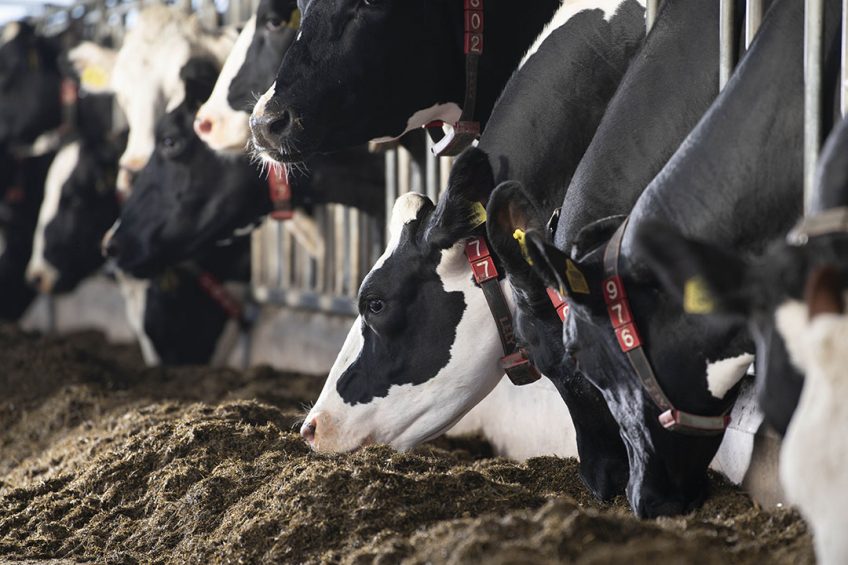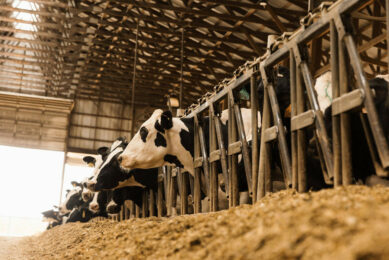Impacts of rumen fluid on gas production

Rumen fluid is commonly used to predict the nutritional value of feed. However, the collection of fresh rumen fluid is complex. This study evaluated whether refrigerated rumen fluid could be a useful alternative to fresh fluid.
Gas production is a common in vitro test in many research centres and commercial laboratories as it is inexpensive, rapid and easy to reproduce with manual or automated systems. However, the collection of rumen fluid requires animals that are cannulated or intubated with oesophageal tubes. Rumen-cannulated animals often require complex procedures to obtain official permits and can have high maintenance costs, while the suction of rumen fluid through an oesophageal probe requires animals to be immobilised and is unsuitable for routine sampling.
Options for collecting rumen fluid
An alternative is to collect rumen fluid immediately after slaughter, but the composition of the feed fed to animals is not always known and it requires access to a slaughterhouse located near the laboratory. Storing rumen fluid while maintaining the viability of the microbial activity would allow the same inoculum to be used for several in vitro runs within a laboratory, with likely advantages in reproducibility.

Alternatively, it would be possible to concentrate rumen fluid collection in specialised centres and transfer inoculum to nearby laboratories. In addition, a reduction in volume by separating a fraction containing most of the bacteria in the rumen fluid would facilitate storage and transportation. Unfortunately, research efforts aimed at preserving rumen fluid for long periods by freezing or freeze drying have not produced satisfactory results in terms of maintaining original fermentation characteristics. However, refrigeration has been demonstrated to be suitable for storing rumen fluid for up to 48 hours.
Aim of study – transfer and storage
Our general aim was to study a procedure to manipulate rumen inoculum in order to facilitate its storage and transfer between laboratories before using it as inoculum for the gas production technique. Specific aims were to test rumen fluids refrigerated in a 24-hour progressive steps storage period; and rumen pellets, obtained by centrifugation of the fresh rumen fluids, which are refrigerated and then reconstituted.
In vitro experiments

The study comprised 2 in vitro rumen fermentation experiments with gas production measured from graduated 100mℓ glass syringes. Rumen fluid was collected at a slaughterhouse from culled dairy cows which had previously been fed under controlled conditions. The inoculum was delivered to our laboratory within 30 minutes from slaughter in airtight glass bottles refluxed with carbon dioxide and maintained at 39°C.
- In experiment 1: a total of approximately 5ℓ of rumen fluid was collected from four cows, mixed and then divided into 5 equal aliquots. The first fraction was used immediately for gas production, while the other 4 fractions were stored in a refrigerator at 4°C in closed bottles flushed with CO2. The aliquots were stored for 24, 48, 72 and 96 hours and then warmed at 39°C, sampled for pH, ammonia and volatile fatty acid (VFA) analysis, and used as inoculum for gas production fermentations. The experiment was repeated 3 times.
- In experiment 2: rumen fluids were collected from 3 cows (1ℓ per cow) and divided into 2 equal aliquots. The first aliquot from each cow was used immediately for gas production. The others were weighted and centrifuged at 13,000×g for 30 minutes at 4°C. The supernatant was discharged, the residual pellet weighed to calculate pellet yield and then refrigerated at 4°C. After 48 hours the 3 pellets were reconstituted to a volume equal to that of the original rumen fluids using warm (39°C) McDougall’s buffer, with 5g/ℓ of added maltose, and were used as fermentation inoculum. The experiment was repeated twice.
In both experiments, the in vitro evaluations were completed on maize grain meal, soya bean meal, wheat grain meal, dehydrated lucerne meal, and a total mixed ration (TMR). Samples of the TMR were dried at 60°C for 48 hours and all feed samples were milled through a 1mm sieve. Approximately 220mg of each dried sample was weighed into 3 graduated 100mℓ glass syringes, which were filled with 30mℓ of dilute rumen fluid. Syringes were placed vertically in a water bath at 39°C, with 3 syringes without substrate as blanks.
Measuring gas production
Gas production was measured at 24 hours in experiment 1 and at 0, 1, 2, 4, 6, 8, 24 and 48 hours after incubation in experiment 2. Syringes were manually agitated every 2 to 8 hours of incubation, and then at 24 hours. In both experiments, we compared the gas production of different aliquots of the same rumen fluid in subsequent incubation sessions (e.g. fresh, refrigerated at 24 hours, refrigerated at 48 hours, etc.). To account for the incubation session effect, standard rumen fluid was included in each incubation session within each fermentation run.
Results of the study
The fermentation of the standard rumen fluid gave similar gas yields among incubation sessions in both experiments (variations less than 5% not shown) and the data was therefore not corrected.
- Experiment 1 – Cooling rumen fluid for up to 96 hours: Refrigeration did not modify total VFA yield, VFA proportions and pH, but increased (P<0.05) the ammonia level in rumen fluids refrigerated for 48, 72 and 96 hours compared to fresh (36,6 to 44,7 vs 23.4mg/dℓ). Gas yields from rumen fluid refrigerated for 72 hours did not differ from fresh inoculum, but there was a decrease (P<0.01) when rumen fluid was used after 96 hours of refrigeration.
- Experiment 2 – Cooling rumen fluid solids for 48 hours: The 6 rumen fluids had different physic-chemical characteristics (pH 6.1 + 0.4; ammonia 22.9 + 13.7 mg/dℓ L; total VFA 111.7 + 13.1 mmol/ℓ) and the pellet yield was 151 + 42 g/kg of the initial rumen fluid weight. There was an interaction between inoculum×feed substrate (P <0.01) for the rate of gas production, but the impact of the interaction to the mean square of the model was much lower than that of the corresponding main effects. Only the results of the main effects of the model are therefore shown and discussed. Maximum gas yield (asymptote) was higher with fresh inoculum compared to that obtained from the pellet (286 vs 263 mℓ/g DM; P<0.01) whereas the rate of degradation showed the opposite pattern (0.072 and 0.093mℓ/h for fresh inoculum and pellet, respectively; P<0.01). In addition, the reconstituted liquid had a longer lag phase compared to fresh (0.70 vs 0.14 hours; P<0.01). Gas production at 24 hours was similar for fresh and pellet inoculum; in the linear regression between gas measured at 24 hours of fermentation from the fresh and pellet inoculum (adjusted for the rumen fluid effect) is shown (R2 = 0.94).
Cold shock response
The concentration of fermentation metabolites in rumen fluid was not changed by refrigeration, apart from an increase in ammonia concentration. Cold shock response is a complex reaction by which bacterial groups adapt to cold temperatures. This includes several metabolic processes, such as modification in membrane lipids and synthesis of proteins able to favour sugar metabolism. It is likely that the higher ammonia levels after refrigeration was due to increased protein metabolism due to cold. It is suggested that a refrigeration phase could improve the subsequent viability of cells due to the protective effect of the cold shock that proteins produced. If so, a practical implication in the field of rumen inoculum preservation could be the investigation of optimal pre-cooling protocols prior to full refrigeration.
Cooling rumen fluid for up to 96 hours
Despite the similarity of fermentative metabolites with 96 hours of cooling, there was a decline in 24-hour gas production at 96 hours of refrigeration. However, these results were not unexpected based on Robinson et al. (1999) who found stable NDF degradability of fresh and 48-hour refrigerated (4°C) rumen fluid. Another study reported that chilling inoculum for 6 hours did not affect in vitro gas production, but 24 hours of refrigeration reduced the fermentation rate. In addition, in 2 other studies the rumen fermentability of fresh rumen fluid was maintained, measured in terms of gas production, when it was preserved for approximately 4 hours at 4 to 6°C.
Cooling rumen fluid solids for 48 hours
Centrifugation is widely used to separate rumen microbes from liquids and feed particulates in rumen fluid. Unfortunately, centrifugation protocols (e.g. centrifugal force, time, and temperature) are not standardised. However, in well-known studies researchers tested 3 centrifugation speeds (5, 10 and 26×103 x g and 5, 17 and 30×103 x g, respectively) for 20 or 30 minutes. As both groups reported no differences in the amount of ruminal bacteria separated by different centrifugations speeds, we used an intermediate value of 13×103×g. A previous study also used this centrifugation speed in preparing a rumen pellet to study the glycogen recovery from rumen microbes when comparing methods for isolating rumen bacteria. In our study, the yield of wet pellet was variable (i.e. 151 + 42g/kg of the initial rumen fluid volume), which probably reflects differences in the particulate density of the rumen fluid collected, despite using a common filtration procedure. Variations in pellet yield will be reflected in reconstituted rumen fluid, which requires the use of blanks (i.e. fermentation from bottles containing only fermentation fluid).
Conclusions
Our results show that rumen fluid preserved by refrigeration (at 4°C until 72 hours) or reconstituted from a refrigerated bacterial pellet (at 4°C for 48 hours), does not depress 24-hour gas production. Refrigerated rumen fluid (or pellet) is an alternative to fresh fluid and would aid in the supply and transport of rumen fluid between laboratories, as well as the potential use of the same inoculum in repeated fermentation runs within the laboratory. This would reduce the need for laboratories to maintain animal donors and/or reduce the frequency of collecting rumen fluid.











